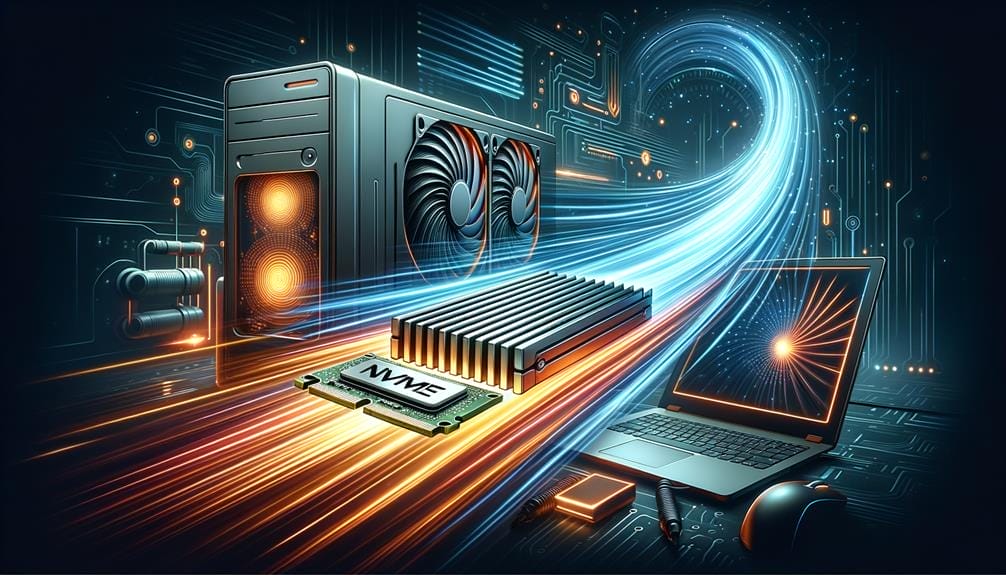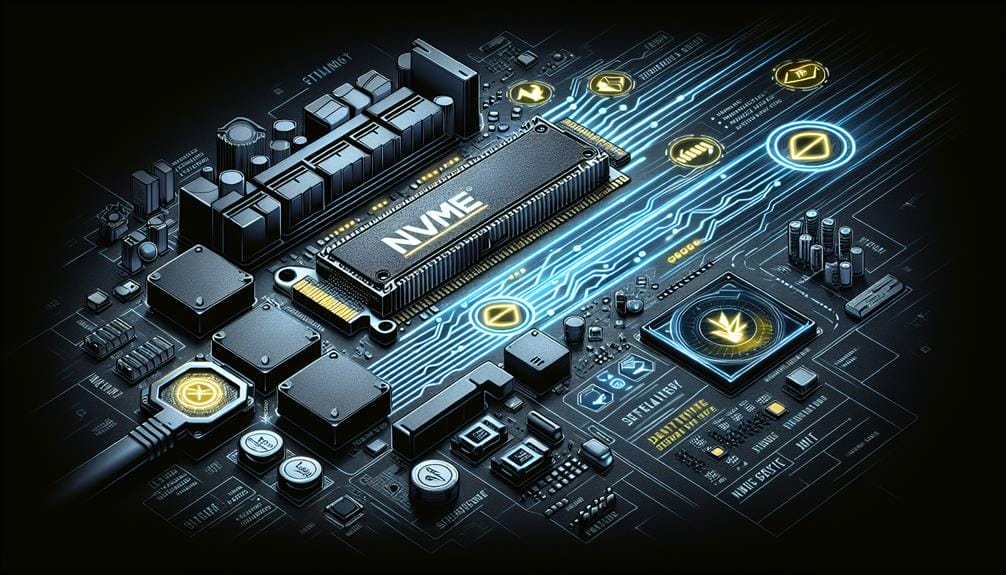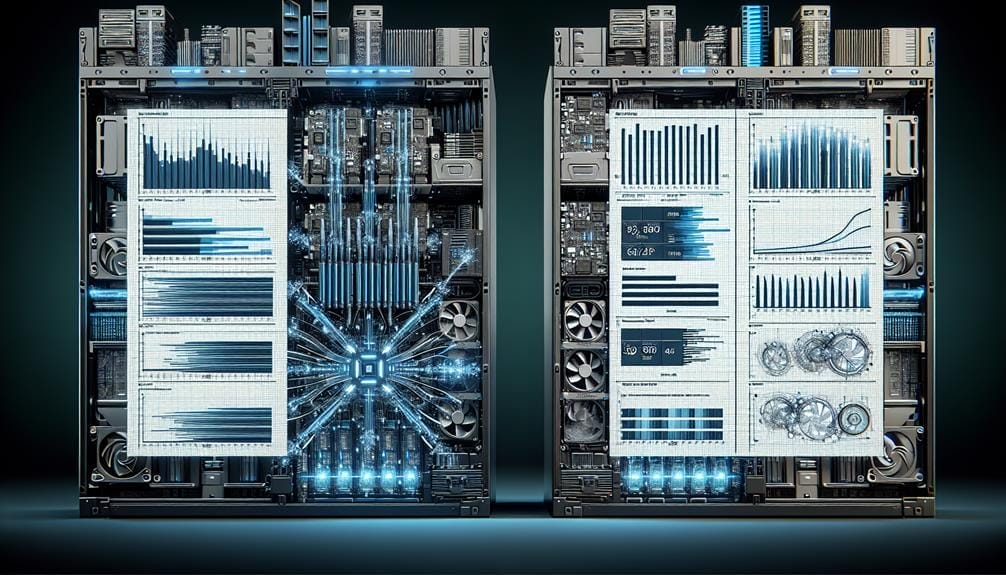Unveiling NVMe: A Speed Evolution

The swift progress of Non-Volatile Memory Express (NVMe) technology has signaled the start of a new era characterized by enhanced speed and greater efficiency in data storage.
As organizations increasingly seek to optimize their storage infrastructure, understanding the intricacies of NVMe and its impact on performance is paramount.
With the potential to significantly enhance computing tasks, from data processing to gaming, delving into the details of NVMe's evolution and its implications will provide invaluable insights for navigating the ever-changing landscape of storage solutions.
Key Takeaways
- NVMe (Non-Volatile Memory Express) is a technology used mainly by M.2 form factor SSDs that offer improved performance and faster data transfer speeds compared to traditional SATA SSDs.
- NVMe drives are available in different generations, with each generation corresponding to the current generation of PCI Express. NVMe Gen 3, Gen 4, and Gen 5 are designed for PCIe Gen 3, Gen 4, and Gen 5 motherboards, respectively.
- Theoretical drive speeds for NVMe Gen 3, Gen 4, and Gen 5 top out at 4 GB/s, 8 GB/s, and 16 GB/s in read/write, respectively. Market drives typically achieve speeds ranging from 2.5 to 3.5 GB/s for Gen 3, 4 to 7.5 GB/s for Gen 4, and around 10-12 GB/s for Gen 5.
- The choice of NVMe generation depends on specific use cases and requirements, and while the speed difference between Gen 3 and Gen 5 drives may not be noticeable in real-world usage, faster NVMe drives are preferred for tasks such as video editing and gaming.
Understanding NVMe Technology

Understanding NVMe technology is crucial for grasping the intricacies of modern storage solutions and their impact on system performance.
NVMe, or Non-Volatile Memory Express, offers numerous benefits over traditional SATA SSDs. The NVMe interface, mainly utilized by M.2 form factor SSDs, leverages PCIe bandwidth, providing faster data transfer speeds and improved system performance.
Compared to SATA SSDs, NVMe drives exhibit significantly higher theoretical drive speeds, with NVMe Gen 5 offering top speeds of 16 GB/s in read/write, surpassing the capabilities of both NVMe Gen 3 and SATA SSDs. While NVMe Gen 3 drives still outperform SATA SSDs, the performance difference between NVMe generations may not be as noticeable in real-world usage scenarios.
Nonetheless, the continuous evolution of NVMe technology underscores its significance in enhancing storage capabilities and overall system performance.
Evolution of NVMe Generations
The progression from understanding NVMe technology to exploring the evolution of NVMe generations underscores the continuous advancement and refinement of storage technologies, particularly in the realm of solid-state drives (SSDs) and their impact on system performance.
NVMe has evolved through different generations, each offering evolutionary advancements in performance and speed. NVMe Gen 3 provided theoretical drive speeds of up to 4 GB/s in read/write, while Gen 4 doubled that to 8 GB/s, and Gen 5 further doubled it to 16 GB/s.
Future developments in NVMe generations are expected to continue this trend of improved performance, with potential advancements in speed and efficiency. As technology progresses, the industry can anticipate further enhancements in NVMe drives, catering to evolving user demands and applications.
Performance and Speed Comparison

With the advancement of NVMe generations, a comprehensive comparison of their performance and speed reveals critical insights for decision-making in storage technology adoption.
NVMe Gen 3 offers theoretical drive speeds up to 4 GB/s in read/write, while NVMe Gen 5 can achieve up to 16 GB/s. Market drives frequently push between 2.5 and 3.5 GB/s for NVMe Gen 3, 4 to 7.5 GB/s for NVMe Gen 4, and current drives are pushing 10-12 GB/s in read and write for NVMe Gen 5.
Real-world performance comparisons indicate that NVMe Gen 5 drives offer the highest performance and speed, with the difference between NVMe Gen 3 and Gen 5 drives being noticeable in various workloads.
Factors affecting NVMe speeds include file transfer, compression performance, and random read speeds, all of which impact real-world usage scenarios.
Use Cases and Requirements
Pivoting from the previous discussion on performance and speed comparison, the assessment of use cases and requirements for NVMe generations is essential in determining their practical applicability and compatibility with specific workloads and storage environments. When choosing between NVMe generations, cost considerations and compatibility requirements play a crucial role. Below is a table comparing the use cases and requirements of NVMe generations:
| Use Cases and Requirements | NVMe Gen 3 | NVMe Gen 4 | NVMe Gen 5 |
|---|---|---|---|
| Cost Considerations | Moderate | Higher | Highest |
| Compatibility Requirements | PCIe Gen 3 | PCIe Gen 4 | PCIe Gen 5 |
Considering these factors is crucial for making informed decisions regarding the implementation of NVMe storage solutions in various computing environments.
Impact on Video Editing and Gaming

Influencing the performance of video editing and gaming, NVMe storage solutions play a crucial role in enhancing workflow efficiency and optimizing gaming experiences.
When it comes to video editing, NVMe drives significantly improve storage optimization, particularly when handling high-resolution, uncompressed media files. The speed and efficiency of NVMe storage are essential for maintaining workflow efficiency, allowing for faster asset transfers, saving progress, and handling other file system tasks.
In the gaming realm, NVMe drives offer faster game loading times compared to traditional HDDs and SATA SSDs, contributing to an improved gaming experience. While the speed differences between NVMe generations may not be immediately noticeable in gaming, future advancements in NVMe technology are expected to further enhance storage performance, benefiting both video editing and gaming applications.
Considerations and Recommendations
Moving from the discussion of the impact on video editing and gaming, it is critical to consider various factors and provide recommendations when evaluating NVMe storage solutions.
When assessing NVMe drives, it is essential to conduct a thorough compatibility assessment to ensure seamless integration with existing hardware.
Additionally, considering the cost effectiveness of NVMe solutions is crucial in optimizing value for performance. It is recommended to carefully evaluate the balance between cost and performance benefits when choosing between different NVMe generations.
Furthermore, understanding the specific use cases and requirements will aid in making informed decisions regarding the most suitable NVMe generation for individual needs.
Conclusion
In conclusion, the evolution of NVMe technology has significantly enhanced data storage and transfer speeds, particularly in the realm of solid-state drives.
Understanding the different generations of NVMe and their implications is crucial for making informed decisions about storage solutions.
By unraveling the nuances of NVMe technology, readers can gain valuable insights into the impact of NVMe generations on different computing tasks.
This knowledge will better equip them to optimize their storage infrastructure for enhanced efficiency and productivity.

